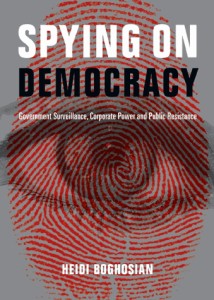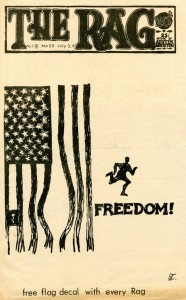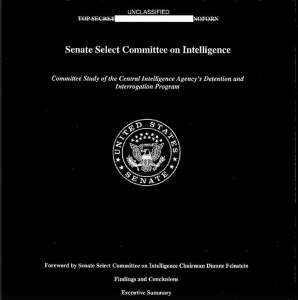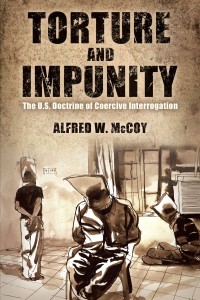Podcast: Play in new window | Download
Updates:
- Hosts Look Back At Several Legal Cases Of 2014
- Professor Steven Salaita Case Update
- Palestinians Join International Criminal Court After UN Rejection
- Michael Ratner: There Is An Immediate Jurisdiction In The ICC On The Occupied Territories
- Michael Ratner: Guantanamo Statistics 2015
- Michael Ratner: Afghanistan War Ends?
—–
Dissent Under Surveillance: Heidi Boghosian
“Dissent Under Surveillance” was a panel held on November 7th at the Cooper Union in NY. It featured our own Heidi Boghosian, along with panelists Kevin Gosztola, Lisa Lynch, Ryan Shapiro and Carey Shenkman. Carey has been a guest on Law and Disorder. The panel was part of The Clandestine Reading Room, an exploration of leaked and declassified documents shedding light on government surveillance and secrecy in the US.
—-
How To Read The Senate Report On CIA Torture
We welcome back author and professor of history at the University of Wisconsin, Al McCoy who recently published the article titled How to Read The Senate Report On CIA Torture. He calls it the single most important U.S. government document released to date in this still-young 21st century, yet its not without particular failings. McCoy distills the report into several potent areas. Among them, he points out how the report shows the “perpetrators as mendacious careerists willing to twist any truth to win a promotion or secure a lucrative contract.” Another is that the CIA has now been forced to admit that any link between torture and actionable intelligence is “unknowable.”
Professor Al McCoy:
- The report gives us a graphic record of just how brutal the CIA interrogations were.
- For years now we’ve been saying enhanced interrogation techniques or the acronym EIT’s or techniques which some consider to be torture, all kinds of twisted euphemisms. Well now, thanks to the senate report on the CIA on interrogation and incarceration everybody, citizen and senator alike, just say torture.
- Another aspect that emerges from the report is a graphic description inside the worst of the CIA managed prisons, the salt pit in Afghanistan. The cold and eternal darkness, the capricious brutality of the CIA interrogators. The absolute incompetence from the point of modern incarceration of the CIA junior prison managers who were sent out without training to run this prison.
- Through all of that the salt pit in Afghanistan can join that long lineage of state human cesspits of suffering.
- Another thing and I think the most important contribution of the senate report is to establish that all the CIA’s claims that brutal coercive interrogation somehow kept us safe, blocked terrorist plots, led us to Osama Bin Laden.
- No longer can the CIA claim the techniques work.
- There’s one little detail that doesn’t seem that important analytically that sticks out and becomes absolutely iconic.
- The iconic part of that report is the fact that the CIA paid 81 million dollars to 2 retired military psychologists who had no training, no language skills, no nothing. These 2 mediocrities are given 81 million dollars to run the CIA psychological and interrogation program.
- The Senate tells us there’s this female operative that was responsible for one of the biggest bungles of the war on terror. The seizure off the streets of a German national named el Mazri. He was rendered to the salt pit in Afghanistan and for 4 months he suffered the vicissitudes of that horrific prison, that iconic hell hole. Then the CIA figures out, oops. This is a complete mistake. This guy is not in any way a terrorist, and they literally dump him on a mountain top in Albania with a wad of cash and have a nice day.
- That operative then also claimed in testimony to the CIA inspector general in 2004 who was investigating the abuses inside the agency’s prisons that these techniques were working. The brutal interrogation, the water boarding of Khalid Sheik Mohammad the top al-Qaeda suspect had led the agency to another suspect named Majid Khan.
- It turned out that Majid Khan was already in CIA custody before the interrogation. Her statement was completely bogus. Who is this person?
- The CIA drew upon her primarily we believe to make her this fictional female CIA operative in Zero Dark Thirty this hero, whose almost obsessive pursuit of Osama Bin Laden and her participation in torture sessions led the Navy Seals to kill Osama Bin Laden in Pakistan.
- Her name is Alfreda Bikowski. She was the one who missed the signals on the 911 plot before it happened.
- She gave systematic false testimony as I described. She led the CIA on a false goose chase on a supposed terrorist cell in Montana and for all that she’s been promoted to the equivalent of a CIA rank as a one star general.
- In 2012, this civil servant had bought an 875 thousand dollar house in Virginia, a luxury residence.
- In short, instead of being reprimanded, demoted, punished for this cacophony of errors, the CIA operative had been rewarded.
- (the senate report) they don’t really explore the history, they don’t tell us where did this psychological torture come from.
- Where did this institutional reflex for torture come from? It comes from a 60 year history of the U.S. involvement of torture.
- The CIA was desperately afraid that the Soviets had somehow cracked the code of human consciousness.
- The sensory deprivation, the sensory disorientation leads to a very quick breakdown.
- Torture up to but not death was legal, and that’s what allowed the CIA to do all this.
Guest – Professor Alfred McCoy is the author of two recent books on this subject—Torture and Impunity: The U.S. Doctrine of Coercive Interrogation (University of Wisconsin Press, 2012) and A Question of Torture: CIA Interrogation from the Cold War to the War on Terror. Welcome to Law and Disorder.
———————————————————-
Please help support Law and Disorder by clicking on Fractured Atlas graphic (link is fixed). This radio show is now a sponsored project of Fractured Atlas, a non-profit arts service organization. Contributions for the charitable purposes of Law and Disorder must be made payable to Fractured Atlas only and are tax-deductible to the extent permitted by law. You can donate as little as 5.00 a month.



